Two-walkers or amphisbaenas are unusual animals, very similar in appearance to snakes or giant earthworms. 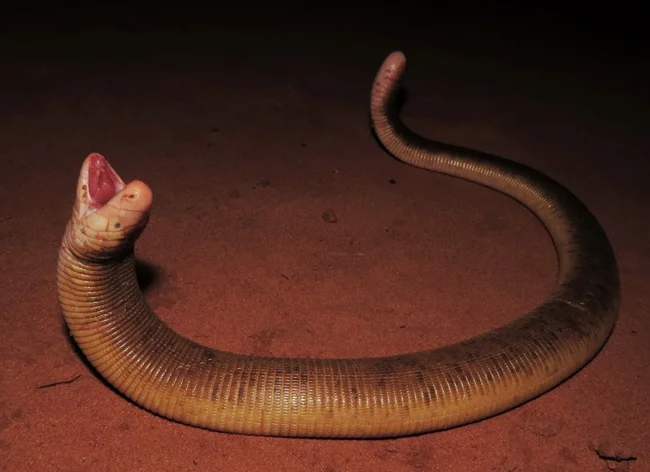
Amphisbaenians, also known as two-year-olds, are a whole suborder of reptiles, which includes more than 200 species. Moreover, they live in all warm regions of the world! Reptiles inhabited all of South America, the coast of sub-Saharan Africa, the Arabian Peninsula and Madagascar. And particularly persistent species colonized the southern regions of Europe and North America. 
But even in these regions, most people are unaware of their existence. And all because in the Upper Cretaceous period, the common ancestor of amphisbaenus decided that he needed to hide underground from prying eyes. Then he looked like a standard, slightly elongated lizard. But millions of years of evolution turned his descendants into something blind and worm-like. And all this regardless of snakes! 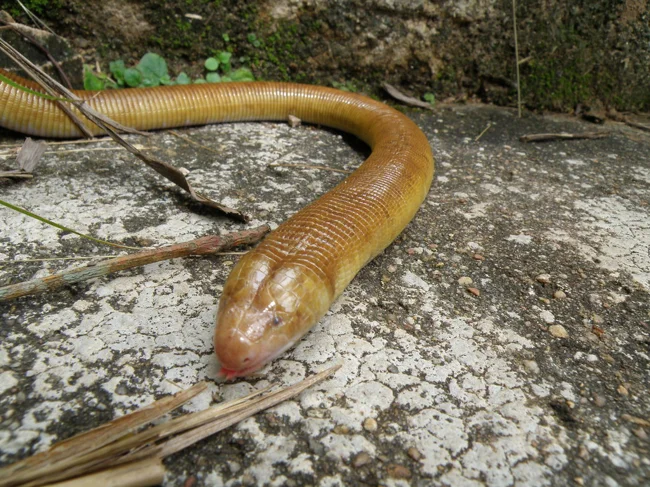
Amphisbaenus can grow the size of a small snake - up to 60 cm in length!
And geneticists, zoologists, and paleontologists unanimously repeat: two-year-olds are in no way related to snakes. Firstly, animals have different skull structures. Amphisbaenas cannot swallow food whole, but they crack the shells of arthropods and the bones of small vertebrates, which snakes cannot do. 
The skull of the amphisbaena is on the left, and that of the snake is on the right. The joke about the Alien is more than appropriate.
Secondly, due to the flat structure of the body, the lizards abandoned part of one lung. Snakes did this too, but there is a nuance. Their right lung was degraded, and Amphisbaenus’ left lung was degraded. 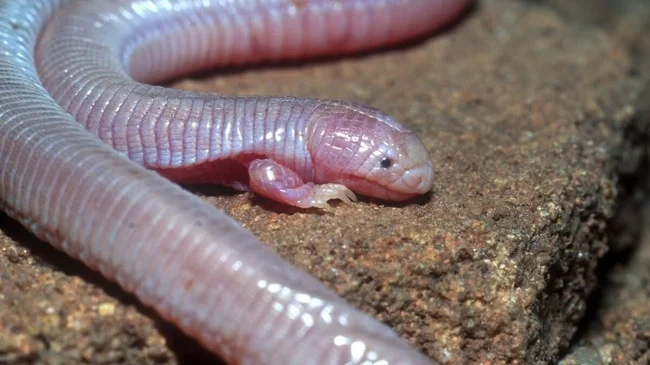
However, 4 species of amphisbaenus retained small front legs. But does this make them happy?
Another remarkable feature of the amphisbaen is the pseudo-head. The tip of the tail, beveled at the top, resembles a head in its shape. It is for this reason that the animal received another name - two-year-old. The reptile's tail is separated from the body as easily as the tails of small lizards. A second of confusion is enough for the amphisbaene to dive into the saving darkness of an extensive network of tunnels. 
Amphisbaenas come to the surface only to warm themselves and mate.
The reptile is safe in the tunnels. There are no large predators underground. But for some species of two-year-old fish this is not enough. They stopped laying eggs and began carrying them inside themselves. After all, this way the enemy will not stumble upon a defenseless clutch while mom is hunting. White amphisbaenas acted even wiser: They hide clutches on the lower tiers of anthills and termite mounds, in areas where social insects store their garbage. There, children do not attract the attention of their owners and find abundant food in the form of insects that feed on the waste of the colonies. 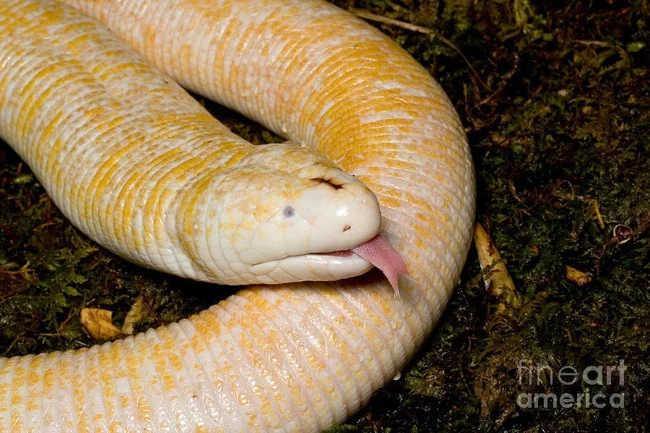
But regardless of the details, the tactic of “hiding and keeping a low profile” shows its full validity. After all, if animals survive 100 million years, then they are doing something right!Very strange animals native to Australia, but different from the famous echidna. Endemic to New Guinea, listed in the Red Book. At the end of the 20th century it was discovered on some islands of Indonesia, most likely introduced by humans.
Peculiarities:
dimensions: body up to 45-80 cm, tail 5-7 cm, thick build, weight 5-15 kg;
coarse wool of dark color, spines 5 cm, light;
high paws, powerful claws, there are spurs on the five-toed paws of males;
It is nocturnal and feeds on worms and beetles.
Interesting Facts:
It reproduces by eggs, the cub is carried in a pouch for 10 days, then the female feeds it in the nest for 10 days. Then he throws himself into an independent life.
2/3 of the echidna's head is occupied by a beak-like rostrum - a combined mouth and nose.
Body temperature can range from 24 to 36 degrees.
6. Capybara 
Capybara. Lat. Hydrochoerus hydrochaeris
Another name is capybara. Today it is the largest rodent leading a semi-aquatic lifestyle. There is a dwarf subspecies. Distributed in Central and South America.
Peculiarities:
dimensions: body length up to 1.4 m, height at withers up to 60 cm, weight of males 30-35 kg, females up to 65 kg;
feed mainly on vegetation;
live in groups led by a dominant male;
They communicate by whistling, very sociable.
Interesting Facts:
At one time, the Pope recognized capybaras as fish, so their meat could be eaten during Lent.
Teeth grow throughout their lives, so capybaras, like beavers, are forced to constantly gnaw on something hard.
They are very trusting and approach people without fear.
7. Holothuria 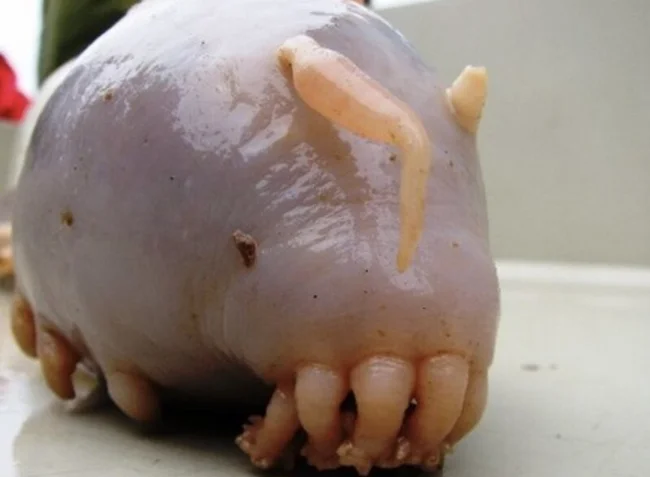
Holothuria. Lat. Holothuroidea
These echinoderm invertebrates are better known as sea cucumbers, egg capsules and sea cucumbers.
Peculiarities:
size from 3 cm to 2 m, there are tentacles;
About 1150 species have been described, more than 100 are found in waters;
lead a sedentary lifestyle, feed on plankton, passing bottom sand through them;
reproduce through eggs, the larvae are immediately autonomous;
a third of holothurians are hemaphrodites.
Interesting Facts:
Scientists are still arguing whether these are animals or plants.
Neither parasites (there are only external ones) nor any bacteria were found in the bodies of sea cucumbers.
These creatures are the only ones in the world that have five-sided body symmetry.
In China, where sea cucumbers are considered a medicinal delicacy, there are farms for growing them.
The oldest holothurians are over 440 million years old.
Without sea cucumbers, the world's oceans would suffer an environmental disaster - they recycle up to 90% of organic waste.
8. Japanese giant salamander 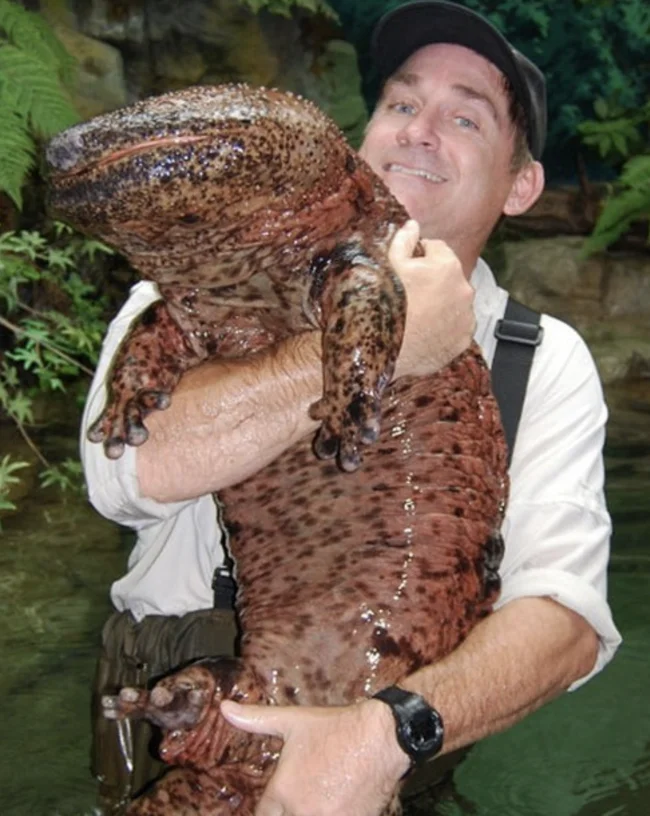
Japanese giant salamander. Lat. Andrias japonicus
Today it is the largest and rarest amphibian on earth. Body length up to 160 cm, weight up to 35 kg. It is assumed that the lifespan is 150 years or more. Other names: khanzaki, kaffa.
Interesting Facts:
It is nocturnal and lives in cold mountain streams.
It feeds on fish, frogs, and insects. Can go for months without food.
The meat is considered a great delicacy, but catching khanzaki is prohibited by law.
9. Sulawi bear couscous 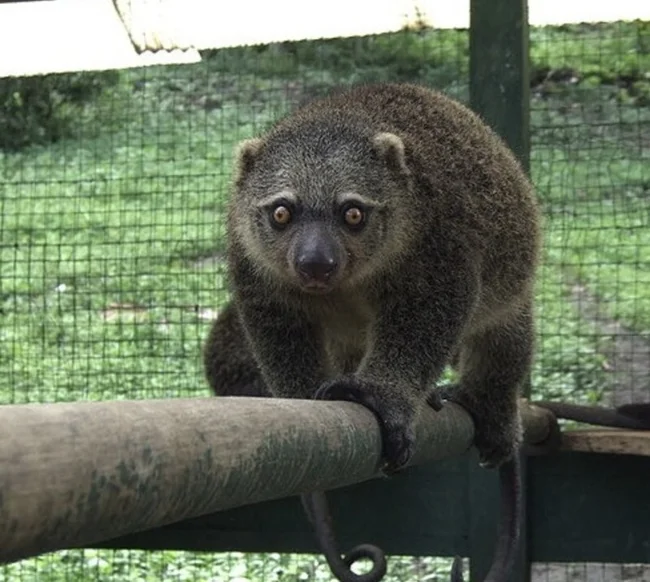
Sulawi bear couscous. Lat. Ailurops ursinus
Unusual marsupials living on the island of Sulawesi and some others in Indonesia. One of the most primitive and ancient marsupials, the origin of which has not yet been studied.
Peculiarities:
lives in tropical forests at an altitude of more than 600 m;
dimensions: body about 55 cm, grasping tail of the same length without hair, weight about 7 kg;
color from gray to brown;
food: leaves, flowers and fruits.
Interesting Facts:
The Sulawi cuscus leads an exclusively arboreal lifestyle; if it falls to the ground, the animal most often dies.
Sleeps or rests almost 20 hours a day.
It is considered a sacred animal, the patron saint of warriors - thanks to its enormous courage.
Locals do not eat couscous, but Indonesian restaurants serve dishes made from it for tourists.
10. Galago 
Galago. Lat. Galago
Primitive unusual primates come from Africa, where they are called bushbabies. For a long time they tried to attribute them to squirrels, cats, and even kangaroos. But then they separated me into a separate group. There are 4 varieties: Somali, Eastern, Southern and Senegalese.
Peculiarities:
sizes: about the size of a small cat;
fur color - from gray to brown, dark circles around the eyes;
give birth to several babies, of which only one, rarely two, survive;
varied diet - insects, small reptiles, fruits, tree sap.
Interesting Facts:
Galagos, despite the fact that they are classified as lower primates, have a developed communication system, a kind of speech with at least 18 “words”.
They can jump over trees at distances of up to 6-9 m.
Galagos use sharpened sticks to extract insects from crevices and stones to crack nuts.
Near Mount Kilimanjaro, there is the Aishi Machame Hotel on the banks of the Weruweru River, where you can interact with tame galagos.
By the way. These animals are one of the most expensive but very comfortable pets.
11. Wombat 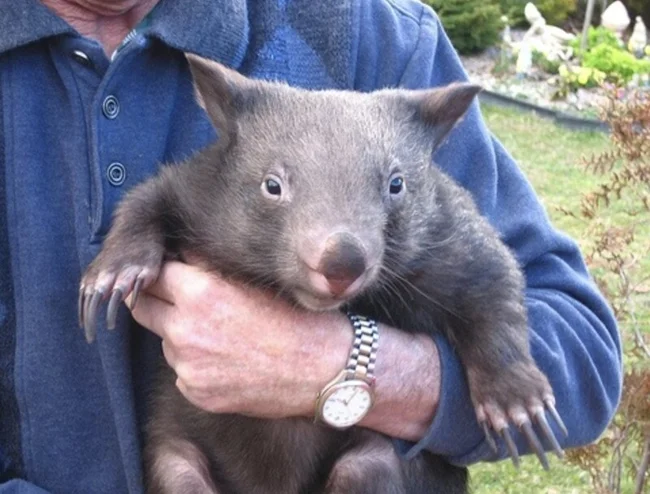
Wombat. Lat. Vombatidae
The only Australian endemic of its kind, it looks like something between a large hamster and a small bear. These rare marsupial herbivores live in burrows and are not relatives of the koala, although there are such versions.
Peculiarities:
dimensions: modern species have from 0.7 to 1.3 m, weight - 20-45 kg;
the fur is hard, the color depends on the place of residence;
Wombats, like camels, can eat and drink once a week.
Interesting Facts:
Wombats are considered to be the oldest rodents that survived the death of dinosaurs.
They see poorly, but hear perfectly and have an exceptional sense of smell - better than hunting dogs.
Wombats can easily climb trees and dive underwater, holding their breath for 15 or even more minutes.
12. Amazonian dolphin 
Amazonian dolphin. Lat. Inia geoffrensis
The pink dolphin is the largest river mammal in the world. It is listed in the Red Book and is not related to the Chinese river dolphin.
Peculiarities:
dimensions: up to 2.5 m in length, weight up to 2 c;
color - light gray, there is a pink variety.
Interesting Facts:
Their brain is one and a half times larger than that of a human, they are very intelligent, and are afraid of people.
They are the only aquatic animals whose heads rotate 180 degrees.
They can swim in a vertical position with their heads down.
They have a magical status among local peoples.
13. Fish-Moon 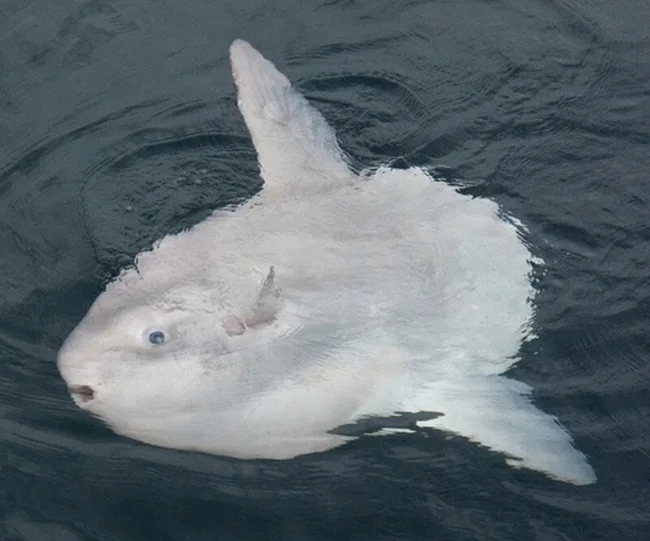
Fish-Moon. Lat. Mola mola
These strange representatives of the ocean depths reach an average of 3 m in length and weigh up to one and a half tons. The largest specimen was caught off the coast of the United States - 5.6 m, weighing 3 tons. Another name is mola-mola.
Peculiarities:
the body of the moonfish is disk-shaped, the skin is thicker than that of an elephant and covered with bone growths;
Often this fish is seen floating on its side on the surface of the water, where it allows birds to collect parasites on its body.
Interesting Facts:
Scientists suggest that these unusual fish can live up to 100 years.
Mola mola lays up to 300 million eggs at a time.
The meat is considered a delicacy in Asian countries and is served in expensive restaurants, just like Fugu fish.
The skin is considered healing and is used in folk medicine in Japan and Korea.
14. Tasmanian devil 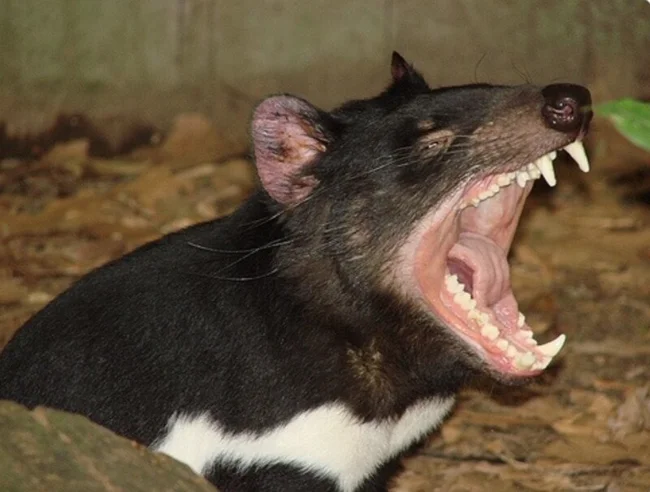
Tasmanian devil. Lat. Sarcophilus harrisii
Rare marsupials are predators, and the Tasmanian devil is the largest of them. In appearance it resembles a bear reduced in size by four times with the tail of a squirrel. It got its name for its viciousness and terrible screams at night.
IF:
It feeds on frogs and snakes and destroys bird nests.
It has the most powerful bite among animals of its size and easily bites through a metal trap.
When in danger, it produces a smelly secretion, almost like that of a skunk.
The baby is born after three weeks of pregnancy and then lives in the mother’s pouch for 4 months. Young individuals keep in flocks.
15. Lori 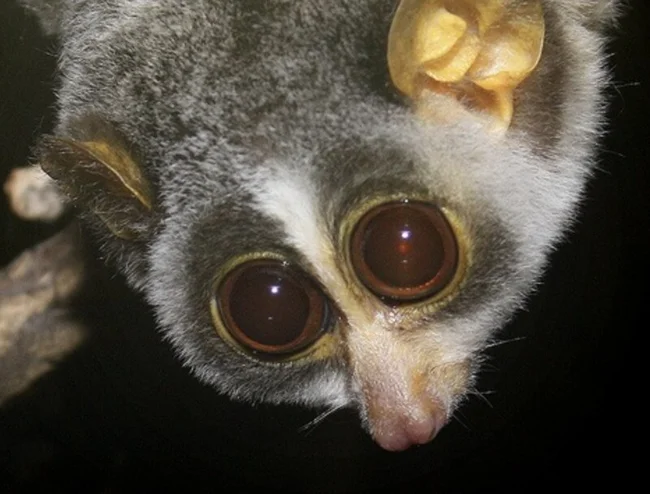
Laurie. Lat. Lorisidae
These unusual primates got their name because their muzzle resembles a clown with very large eyes (Loeris in translation means “clown”).
Peculiarities:
There are 16 subspecies of loris, they are relatives of the galago;
small sizes - body 20-40 cm, weight 0.3-2 kg;
lead an arboreal lifestyle, are active at night, feed on insects, bird eggs, and fruits.
Interesting Facts:
They are the only primate to have blue eyes.
There are poison glands on the front paws. The animal coats its teeth with poison before biting.
They can be domesticated, and in some Asian countries they are kept as pets.
16. Gavial 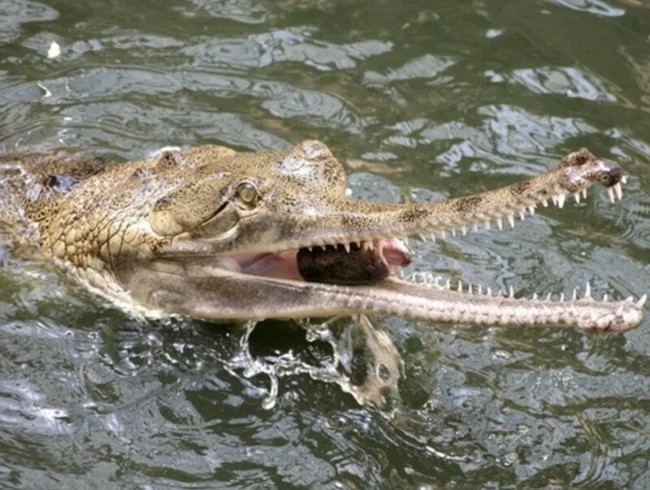
Gavial. Lat. Gavialis gangeticus
A very unusual representative of the crocodile order. The Gangetic gharial is common in India and neighboring countries, lives in deep reservoirs, feeds on fish, which it catches with its long mouth with sharp curved teeth.
IF:
Body length can reach 5.5 m, weight up to 180 kg.
The gharial's mouth lengthens throughout its life.
Moves by crawling on its belly due to weak legs.
They can hunt dogs, goats and buffalo calves.
The female lays 40-60 eggs in the warm sand on the shore, the hatched crocodiles move into the water on their own, and along the way half die from birds and predators that are waiting for them on purpose.
17. Okapi 
Okapi. Lat. Okapia johnstoni
p>These rare animals are on the verge of extinction. Also known as forest giraffe, Johnston's horse, dwarf giraffe, zebra giraffe. Now they are found only in the dense forests of the Congo, but during the Ice Age they were distributed throughout Africa and Europe.
Peculiarities:
body up to 2 m long, height 1.8 m, females are taller, weight up to 250 kg;
on the legs and thighs there are black and white stripes, like a zebra;
males have small horns.
Interesting Facts:
Okapi have such a long tongue that they can wash their eyes and ears with it.
The wool is very beautiful, velvety, red-brown in color, and is highly valued.
The first living okapi was caught only in 1909; the animals are very timid and avoid meeting people.
During the day, the forest giraffe eats up to 30 kg of grass, leaves and fruits.
18. Wallaby 
Wallaby. Lat. Macropodidae
These rare marsupials are also known as tree kangaroo, tharibina, marsupial bear, philander, padeleron, mountain kangaroo, marsupial hare. They live in the tropical mountain forests of New Guinea and Australia.
Peculiarities:
there are dozens of subspecies of wallabies, differing in size - from those like hares to gigantic striped ones;
wallabies are excellent jumpers, jump up to 10 m, easily climb trees thanks to their long curved claws;
The basis of the diet is plant foods, berries, fruits and mushrooms.
Interesting Facts:
The bear wallaby looks like a teddy bear, but has a stern disposition.
They lead a gregarious lifestyle, with a dominant male and a harem of several females with cubs.
They sleep in tall trees to protect themselves from wild dingoes.
19. Wolverine 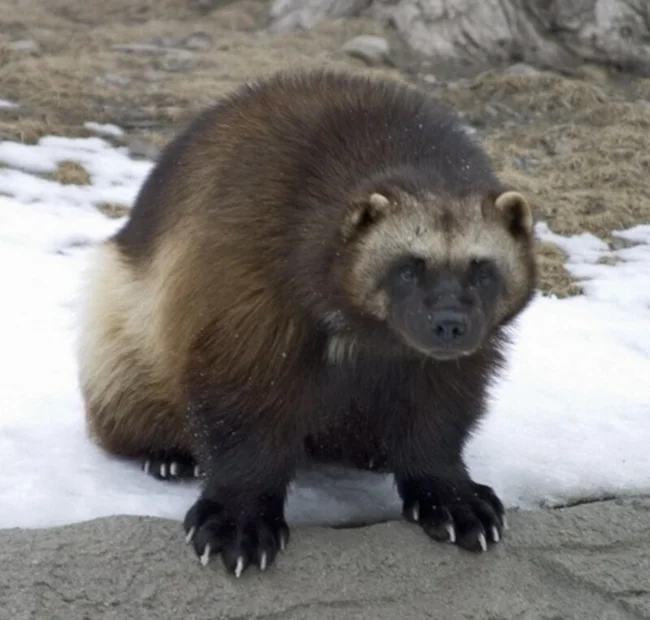
Wolverine. Lat. Gulo gulo
One of the most ferocious predators of mid-latitudes, which even bears are afraid of. These rather rare animals are also known as gulos and are relatives of the marten.
Peculiarities:
the size is small - about the size of a dog, but in appearance it looks like a badger, the muzzle is cat-like, barks like a fox;
wolverines feed mainly on carrion, but can hunt birds and small animals;
runs quickly, clubbing as it goes due to its huge curved claws; they help it easily climb trees where the wolverine destroys bird nests.
Interesting Facts:
Wolverines are not liked because of their aggressiveness and attacks on poultry, rabbits, and piglets.
Lives in a den under upturned trees; the hunting area can reach 2000 square meters. km, protects him, driving away strays.
The female bears offspring once every two years, the babies live with her until new ones appear.
Wolverine fur is highly prized; it was used to make fur coats for the royal family.
Wolverines tamed from childhood behave like dogs.
20. Fossa 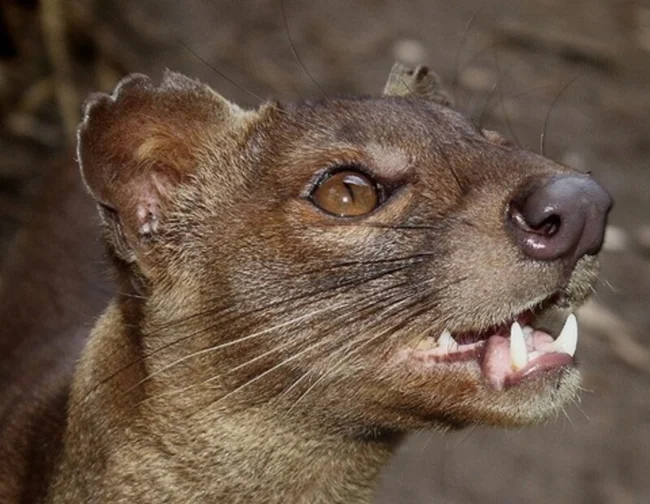
Fossa. Lat. Cryptoprocta ferox
The only representative of the genus of predatory civets, lives only on the island of Madagascar. Other names: Madagascar lion or puma, angry squirrel, Madagascar jaguarundi.
Peculiarities:
body up to 70 cm long, equally thick tail;
elongated muzzle, high paws, runs quickly, can climb trees;
lead a twilight lifestyle;
They feed on insects, amphibians, small animals and bird eggs.
Interesting Facts:
Strange facts about Fossa excite zoologists - from one to four years, females grow a penis with a bone inside, and then it dissolves.
Mating lasts up to 3 hours, and it occurs on the tops of trees, and the animals themselves howl wildly.
Madagascars are very afraid of fossas and try not to intersect with them.
21. Pallas's cat 
Manul. Lat. Otocolobus manul
Manulas are the most unusual of the cats, they have several names - Pallas's cat, mountain wild cat, evil cat. They live in mountains and steppe areas.
Peculiarities:
the size of a domestic cat, males are larger;
feed mainly on rodents, destroy nests;
their meowing is similar to barking, they can purr.
Interesting Facts:
Manuls are very difficult to tame; in captivity they become depressed and die of hunger.
They have the thickest fur of all animals - 9000 hairs per 1 square cm, each up to 7 cm long.
The name Manul translates as “ugly ear.”
22. Fennec 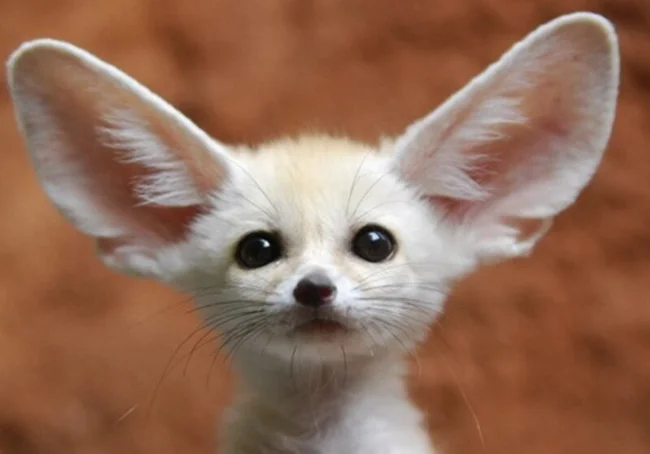
Fenech. Lat. Vulpes zerda
Also known as the steppe or long-eared fox. Lives in the steppes of northern Africa and is the national animal of Algeria.
Features and interesting facts:
this is the smallest animal of the Canids, smaller than a cat;
large ears help detect insects by sound;
the paws have dense fur, which allows them to walk on hot sand;
young fennecs are completely white, the sand color appears when they reach maturity;
live in family clans, actively communicate with each other;
monogamous, couples choose for life; if a partner dies, they do not form a new family;
live in burrows, the length of which can reach 120 m.
23. Naked mole rat 
Naked mole rat. Lat. Heterocephalus glaber
In the “strangest animals” group, this burrowing African rodent will definitely be among the leaders. Here are just some unusual facts about him:
the animal has no hair;
he has cold blood;
insensitive to pain;
the colony numbers up to 80 individuals, has a complex organization with a ruler - a royal female, nobles and simple workers;
life expectancy - up to 40 years (mice live one and a half years, rats 3-4);
these rodents never get cancer;
per year the queen brings 5 litters, she has a harem of selected males, during her life she gives birth to up to a thousand cubs;
the remaining females never mate and can only be workers;
After the death of the queen, the females stage fierce battles for the right to take her place.
24. Palm thief 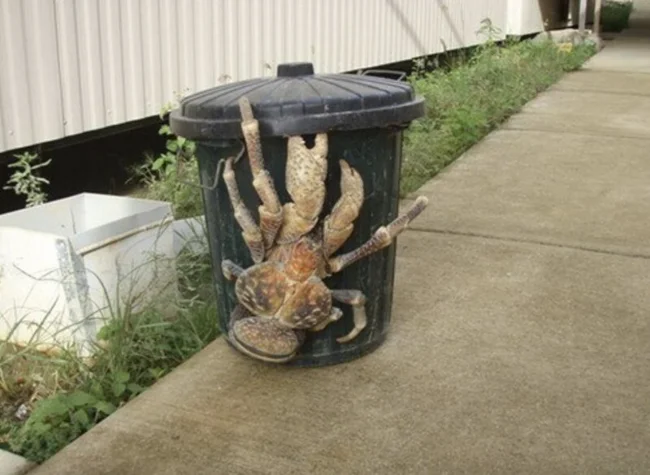
Palm thief. Lat. Birgus latro
One of the most creepy-looking representatives of crustaceans. Lives on the tropical islands of the Indian and Pacific oceans, in Australia and New Zealand.
Peculiarities:
this strange cancer is land, climbs trees for coconuts, which cuts off coconuts with its claws and drops them from a height so that they split;
got its name for stealing crops, it is also called tree or coconut crab, thief crab;
In addition to coconuts, he loves the roots of various plants, eats crabs and even his relatives.
Interesting Facts:
Until they grow up, these crayfish live in water, feeding on organic debris that has fallen to the bottom, and dragging a house shell with them. They crawl onto land when they are adults and never return to the water, only to shed their eggs.
It has gills and full lungs.
The meat of this crab is very tasty, but since their numbers are small, fishing is allowed only once a year under certain conditions.
25. Smallmouth macropinna 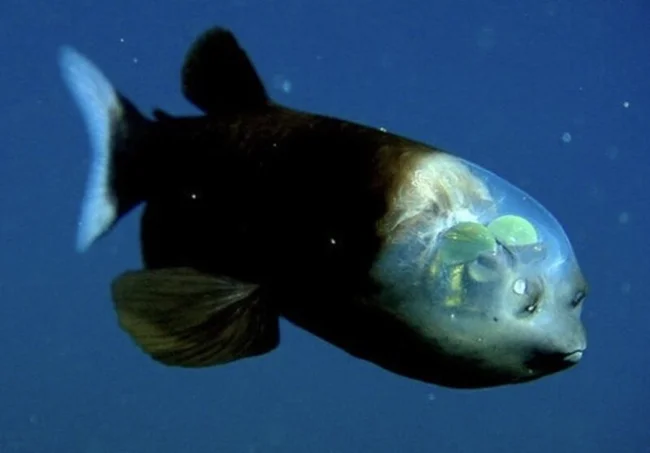
Smallmouth macropinna. Lat. Macropinna microstoma
Other names: barrel eye, fish with a transparent head. Belongs to deep-sea ray-finned fish, discovered in 1939.
Features and IF:
lives in the Pacific Ocean at a depth of 500-800 m;
The head of the barrel eye is transparent, tubular eyes and brain are visible, the mouth is very small;
the size of the fish does not exceed 15 cm;
eyes look exclusively upward;
in the dark, a greenish glow appears around the eyes, which lures prey - zooplankton.
26. Echidna 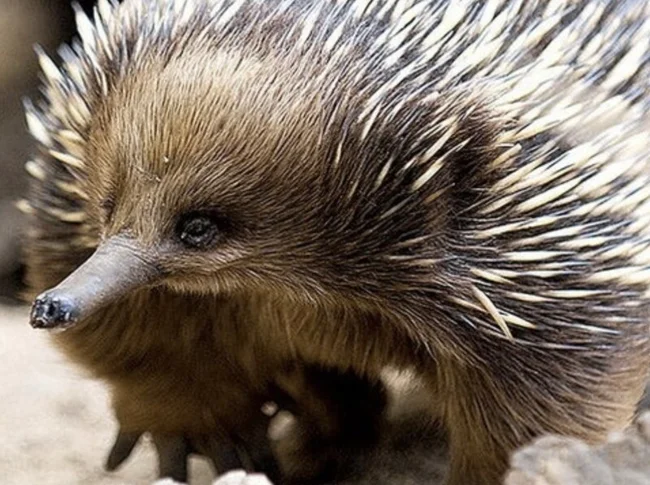
Echidna. Lat. Tachyglossidae
The strangest Australian endemics, like their distant relative, the platypus. They are oviparous marsupials.
Peculiarities:
a small animal that looks like a hedgehog and a porcupine at the same time, can curl up into a ball, has fur and sharp needles, which are actually hair;
Echidnas live alone and mate once a year;
the female lays one egg, which she places in a pouch;
the baby hatches after 10 days and feeds on milk, which is secreted through pores on the stomach (the echidna has no nipples);
after 50 days, the baby's needles begin to grow, then the mother digs a hole for him, but continues to feed him milk until 7 months.
Interesting Facts:
They have a beak that looks like a trunk, practically no teeth, they feed on ants and termites, which they catch with a long tongue with sticky saliva.
The echidna received its name in honor of the ancient Greek goddess - “the mother of all monsters.”
Body temperature is the lowest in warm-blooded animals - 32 degrees.
27.Less red panda 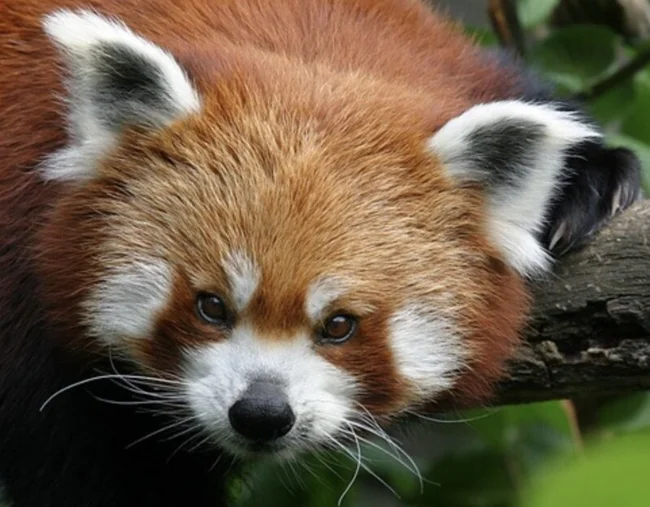
Small red panda. Lat. Ailurus fulgens
This unusual animal is on the verge of extinction. Also known as cat bear, red bamboo bear, little panda, ho-hu, puunya.
Peculiarities:
the size of a large cat;
is a predator, but feeds on plant foods and can destroy bird nests;
not related to the giant panda, but has a similar lifestyle.
IF:
Red pandas chew 13 hours a day and sleep the rest of the time. They practically don’t go down to the ground because they walk poorly.
They make sounds similar to chirping.
They live in pairs, the cubs are raised in hollows.
The species is listed in the Red Book, but about 350 animals have already been bred in captivity and released in the forests of China.
28. Sifaka 
Sifaka. Lat. Propithecus
Sifakas are rare animals of the island of Madagascar, were discovered only in 2004. These half-monkeys are half-lemures and are also called crested indris, verroes, diadema lemurs and hemipithecus.
Features and IF:
The height of the sifaka is about half a meter, the tail is the same length;
paws are long, with thumbs for grasping branches;
the fur is thick, light gray, the paws are brown, the muzzle is black, smooth, without hair;
the female gives birth to one cub every three years;
Sifakas are excellent at jumping from tree to tree, flying 10 meters or more even with a baby on their back;
Local residents believe that the souls of the dead move into the sifak and treat them with respect.
29. Sloth 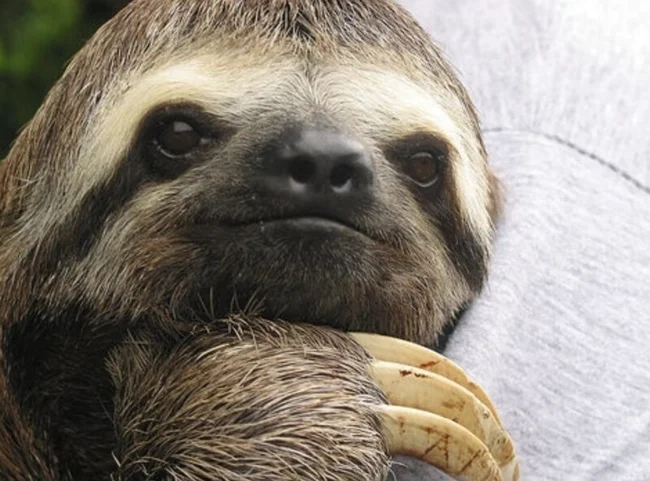
Sloth. Lat. Folivora
Animals that are unusual in appearance and lifestyle are also known as leaf beetles or bradius. They live in the tropical jungles of Central and South America.
Features and IF:
Sloths are extremely slow, eating almost 18 hours a day. In a well-fed animal, 2/3 of its weight is taken up by a full stomach. In addition to leaves, they do not disdain insects and tree lizards.
The coarse fur of leaf beetles has a greenish tint due to the presence of blue-green algae, which is found only on sloths. The fur coat also grows symbiotic mushrooms, which people have discovered have anti-cancer properties.
After the baby is born, the first thing the mother does is rub against it to colonize it with algae.
Animals climb down from trees only to go to the toilet.
Sloths have a different number of cervical vertebrae - from 5 to 9. Scientists do not yet understand why this is so.
30. Platypus 
Platypus. Lat. Ornithorhynchus anatinus
The platypus, like the echidna, is a symbol of Australia. For a long time, scientists could not understand which species to classify this strange animal as: mammals, birds, fish or reptiles. Judge for yourself:
Platypuses are waterfowl, but they do not have gills.
The eggs are laid in a pouch, but the young are fed milk.
Like birds, they have a cloaca.
A flat tail is similar to a beaver's, and fat accumulates there.
The eyes, nostrils and ears are located in grooves, which close when diving and the animal orients itself only by touch.
Has the ability to pick up electrical impulses from living beings.
Its saliva is toxic; the venom from a bite can kill a dog.
It feeds on bottom organisms, breaking up mud.
Other names: duck mole, water mole, beaver duck.
31. Anteaters 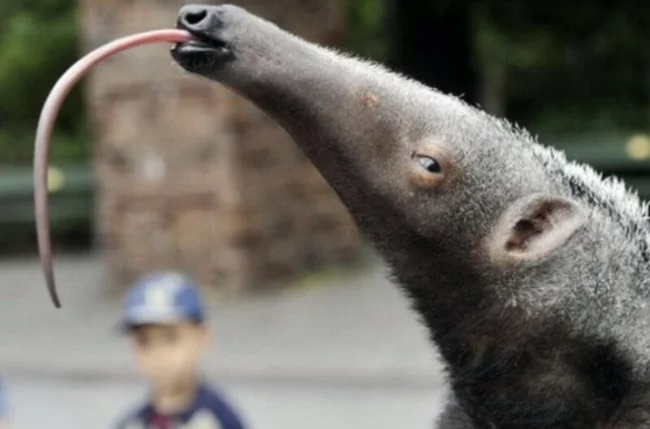
Anteaters. Lat. Vermilingua
Very strange animals are represented by three species - giant, dwarf and Colombian tamandua. Distributed in Central and South America.
Features and Interesting Facts:
are mainly nocturnal;
they have no teeth, feed exclusively on ants and termites, reaching them with a very long thin tongue - 60 cm, the anteater destroys up to 30 thousand insects per day;
The giant species does not climb trees, but the dwarf species lives there permanently.
32. Tarsier 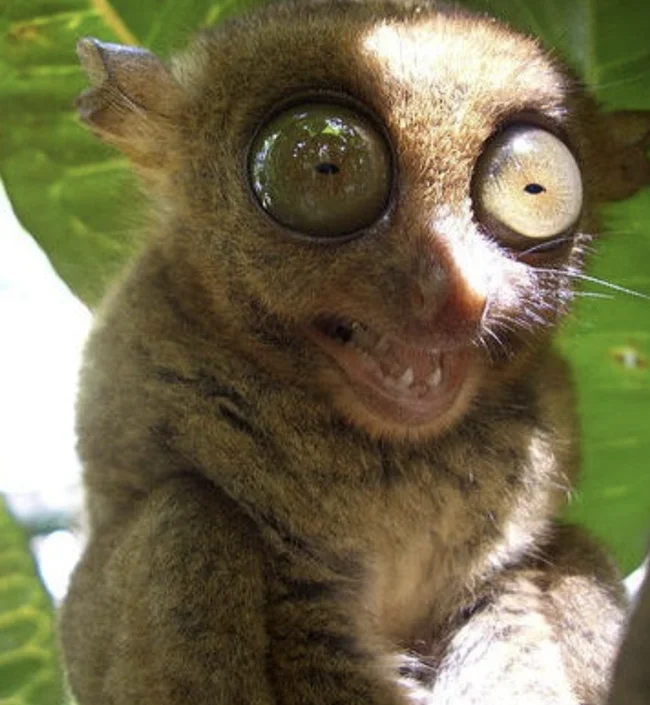
Tarsier. Lat. Tarsius
Rare small primates (10-16 cm) with the most non-standard appearance. Here are the most amazing facts about the Philippine tarsier:
it has the largest eyes compared to the size of the head;
tarsiers have a bad reputation in their homeland, where they are considered evil spirits;
pregnancy lasts 6 months, the baby is born weighing about 20 g and is placed in a tablespoon, the mother carries it on herself for six months;
this animal became the prototype for Master Yoda in Star Wars.
33. Margay 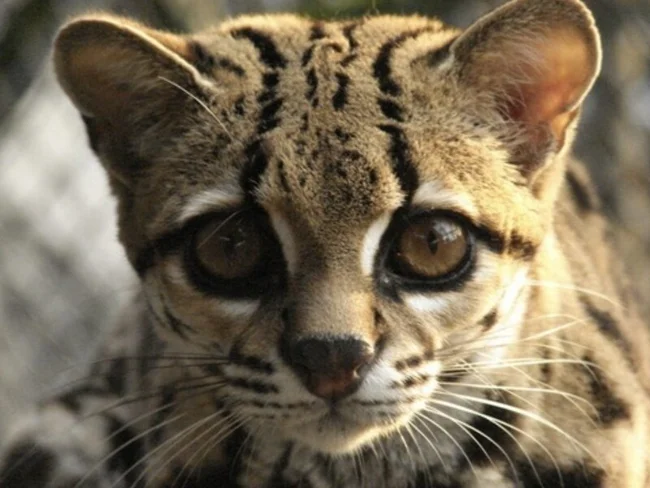
Margay. Lat. Felis wiedii
One of the rare wild cat species found in Central and Latin America. Externally, the margay is similar to an ocelot, only half the size. Other names: margi, Vida leopard, forest long-tailed cat, tree leopard, squirrel cat.
Features and Interesting Facts:
The margay hunts and spends most of its time in trees, easily jumping from branch to branch on its long legs. The very long tail helps control the body in flight.
It is nocturnal, feeds on small animals and birds, and does not refuse fruits.
Unlike other cats, the margay can descend vertically, head down, and turn around in the air, like a squirrel.
34. Mudskipper 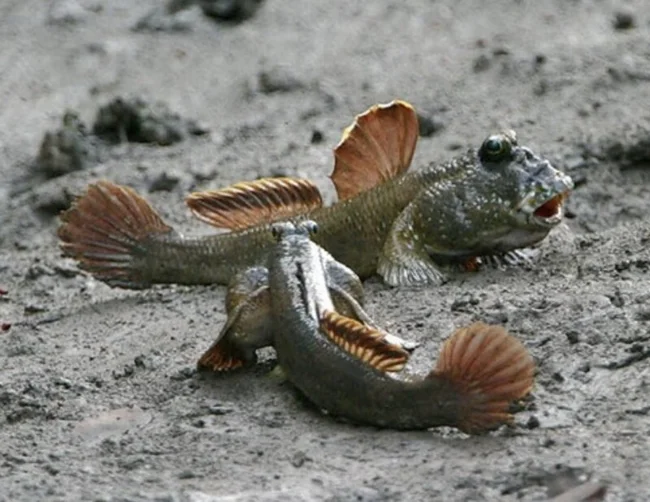
Mudskipper. Lat. Periophthalmus
The “unusual animals” group would be incomplete without these amazing fish. They are found in mangroves in places where fresh water mixes with sea water. Scientists consider them to be a transitional form from fish to amphibians.
Features and interesting facts:
thanks to their large front fins, jumpers not only crawl well through mud, but can even climb trees, where they catch insects in flight;
in water they breathe through gills, and on land - through the skin and swallowed water;
they feed on plant debris and small organisms that are dug out of the silt;
They were called jumpers because of their high jumps during the mating period;
They have large mobile eyes that provide a 360-degree view.
35. Herbivore Dracula 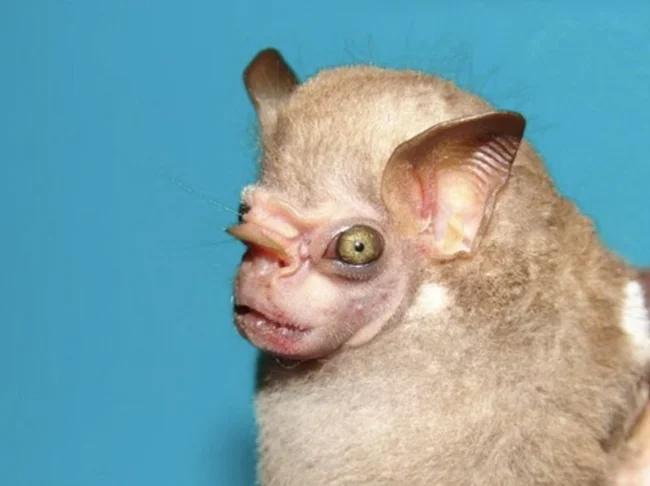
Herbivore Dracula. Lat. Sphaeronycteris toxophyllum
These strange bats live in the Amazon region. Despite their creepy appearance and impressive name, the animals are completely harmless, do not drink blood from anyone, and feed on plants and fruits. They are also called grass fighters.
Interesting Facts:
There are almost 200 varieties of Dracula.
They love solitude and rarely live in permanent pairs.
Their wings are very thin, similar to gauze. This is enough to fly from tree to tree.
Local residents consider dracs to be the personification of night demons.
36. Belttail 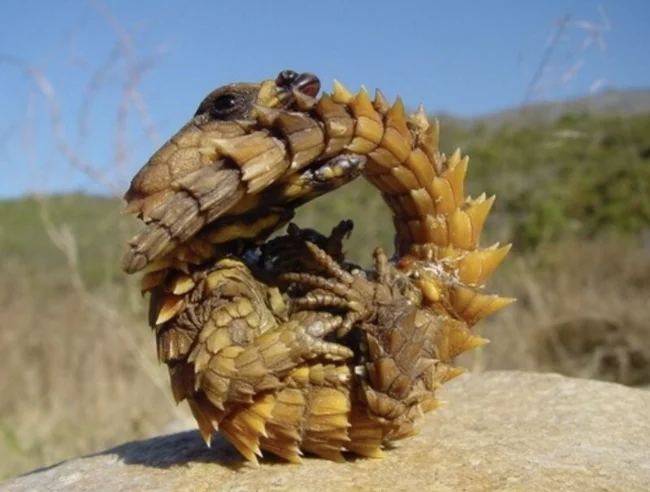
Belttail. Lat. Cordylidae
One of the most amazing reptiles: the lizard’s body is covered with real scales. There are thorns on the scales; when in danger, the animal curls into a ring, putting up protection. At the same time, it holds its tail tightly with its teeth so that it is impossible to untwist it. They are also called cordylids and African dragonets.
Interesting Facts:
They live in Africa and on the island of Madagascar.
Small subspecies feed on insects, while large ones catch other lizards, frogs and rodents.
Some belttails lay eggs, and some are viviparous.
Males are very aggressive towards each other.
Lizards grow new teeth several times during their life. The severed tail also grows back.
37. Purple frog 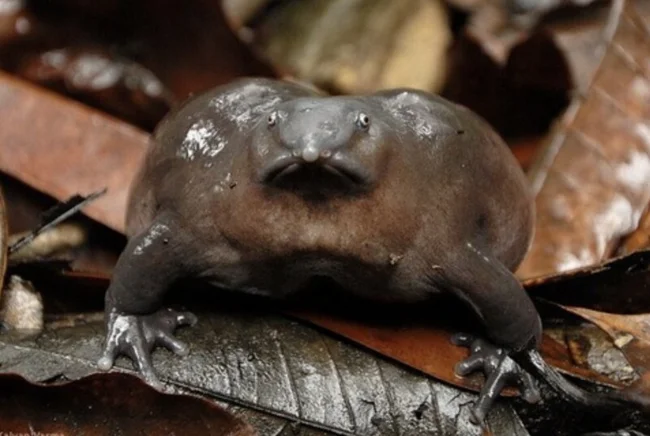
Lilac frog. Lat. Nasikabatrachus sahyadrensis
Other names: Indian monsoon toad, purple frog, frog mole (lives underground). It was opened only in 2003. Recognized as the strangest amphibian because of its stupid appearance: a thick body with thin legs, a small head with an elongated nose and an unpleasant smell. It feeds on insects and worms, breeds during the monsoon rains, throwing eggs into temporary reservoirs. Little studied.
38. Sun Bear 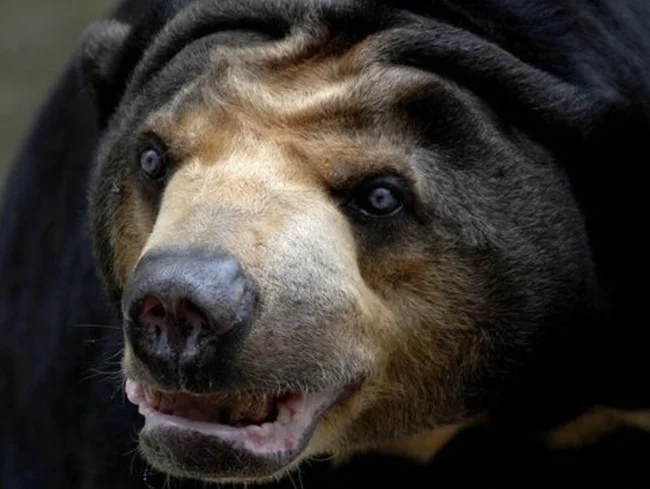
Solar bear. Lat. Helarctos malayanus
The unusual species has many names: biruang, Malayan bear, Javan yellow, dog bear. There are several dozen of these animals left in the world; they were destroyed by humans because of their very beautiful brown-golden short fur and because of their special malice towards people.
Interesting Facts:
This is the smallest bear among all - its height does not exceed 70 cm.
Its tongue reaches a length of 25 cm, and its sickle-shaped claws are 12-15 cm. With them, it destroys bee nests and termite mounds, extracting larvae and honey with its tongue.
The biruang spends most of its life in trees.
When walking he gets very clubbed.
It is distinguished by its intelligence, luring prey into traps prepared by it.
Biruang organs are widely used in folk medicine.
39. Tibetan fox 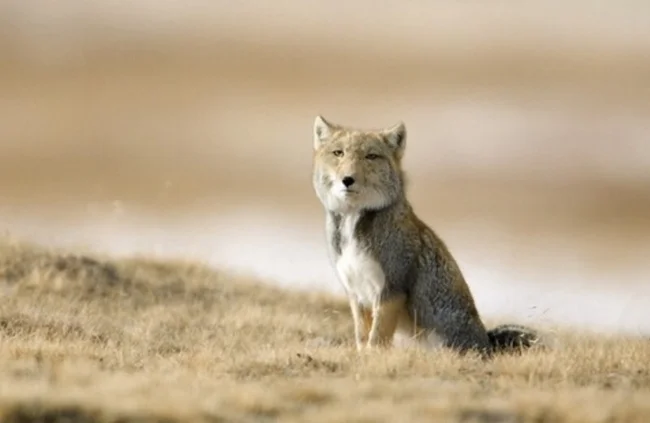
Tibetan fox. Lat. Vulpes ferrilata
A strange-looking animal, more like a fat wolf or a swollen dog with narrow eyes. The head has a square shape due to the furry mane on the neck. The animal is so imperturbable that it has become a symbol of “universal indifference.”
Interesting Facts:
The Tibetan fox is small in size, slightly larger than a domestic cat, weighing no more than 5 kg. Has short legs and a bushy tail.
The fur is dirty yellow in color with dark spots on the sides.
The diet consists of pikas and various rodents, destroys bird nests on the ground, and picks up carrion.
The first time we managed to film these animals was in 2006.
40. Aye-aye 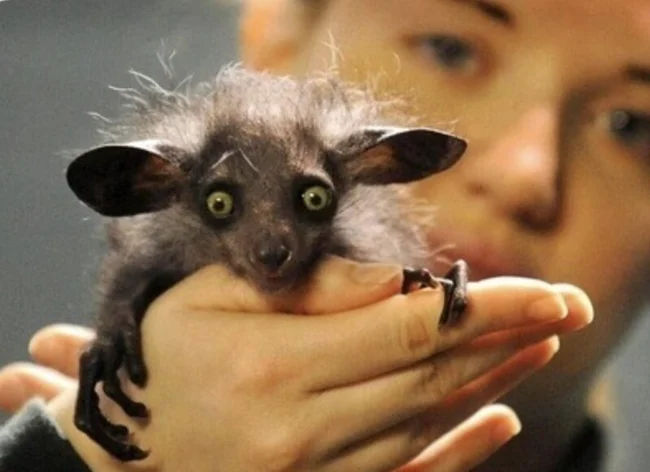
Ay-ay. Lat. Daubentonia madagascariensis
Other names are Madagascar monkey, woodpecker monkey, the rarest, endangered species, there are about two dozen of them left. This primitive primate got its strange name because of its awkward, frightening appearance; when someone saw it, they immediately gasped in fright.
Features and Interesting Facts:
Little arms live in trees and use their long claws to pick out insects and larvae from crevices.
The animal’s body is no more than 40 cm in length, but its gorgeous bushy tail grows up to 60 cm.
They have large ears and eyes that can see well in the dark.
An aye-aye's teeth grow throughout their lives, so they have to be ground down by gnawing on wood.
The monkeys have the longest fingers of any primate, and the middle 6th finger can rotate 360 degrees.
In Madagascar, the aye-aye is very feared, its name is not spoken out loud, and whoever kills the animal will soon die.
42. Lamprey 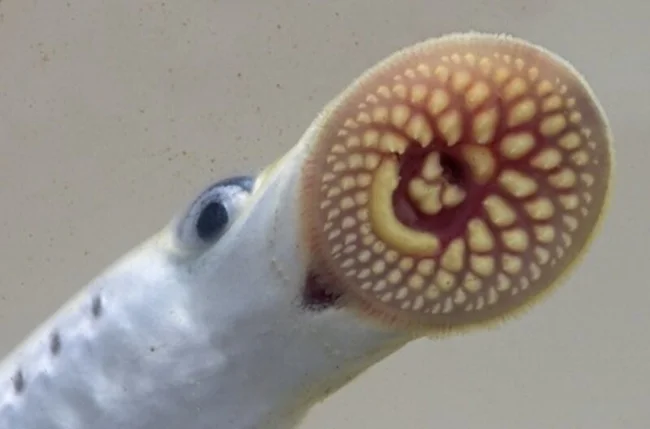
Lamprey. Lat.Lampetra fluviatilis
The most terrible of river fish. Also lives in the Arctic Ocean. This parasitic fish can grow up to 1.2 m in length, and with its round mouth with numerous teeth, it latches onto the fish, sucking the blood out of it. Small lamprey specimens can be completely sucked in.
Spawning occurs in sand nests built by the male. The larvae live nearby for 3-4 years, feeding on small organisms in the sand, for which they are nicknamed sand miners.
Lamprey meat is a delicacy and is served in expensive restaurants. Due to uncontrolled fishing, the number of the species has sharply decreased and now the Neva lamprey is listed in the Red Book.
Important! If a lamprey bites a person, you should immediately go to the hospital, as the blood in the wound will not clot and blood loss can be life-threatening.
43. Star-nosed 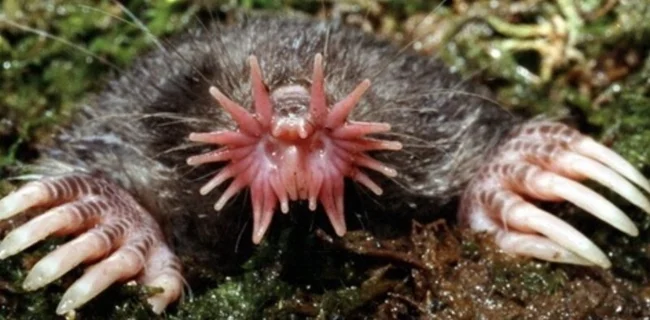
Star-nosed. Lat. Condylura cristata
The group “unusual animals” would be incomplete without this underground inhabitant. In general, it differs little from an ordinary mole, except that on its snout it has a rosette of 22 bright red fleshy rays. This is a kind of organ of touch with which the starfish checks the edibility of found objects.
Interesting Facts:
The star-nosed fish's eyes are small and almost blind.
There are no ears, there are gaps in the skin.
It has 44 teeth, the incisors are very sharp, designed for killing prey.
In winter they do not hibernate; they look for food at greater depths.
The animal swims and dives well, catching small aquatic creatures, including tadpoles.
You can also find the star-nosed insect on a forest path, where it crawls out to look for insects.
0 comments
